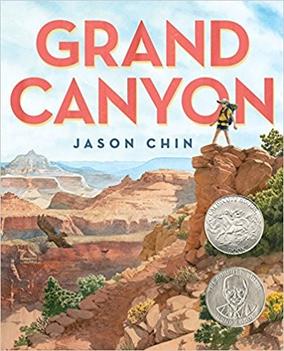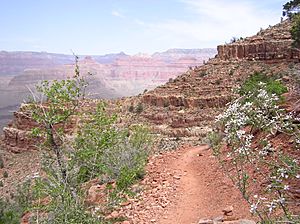Grand Canyon (book) facts for kids
 |
|
| Author | Jason Chin |
|---|---|
| Publisher | Roaring Brook Press, Macmillan Publishing |
|
Publication date
|
February 21, 2017 |
| Pages | 54 |
| Awards | Caldecott Honor, Sibert Honor |
| ISBN | 978-1-59643-950-4 |
| OCLC | 1059176926 |
Grand Canyon by Jason Chin is an amazing picture book published in 2017. It takes you on a journey through the Grand Canyon. The book explores the plants, animals, and different environments found there. It shows them both as they are today and how they were long ago.
The story is told through a fun hiking trip. Jason Chin got the idea for the book from a trip he took in high school. This book was special because it was the first time Chin used a technique called die cuts. He also used his usual art tools like pen and ink, watercolors, and gouache.
Grand Canyon won some big awards! It received a 2018 Caldecott Honor for its beautiful pictures. It also got a 2018 Sibert Honor for its interesting and informative text. It's quite rare for a non-fiction book that isn't a biography to win a Caldecott award.
Discover the Grand Canyon's Secrets
Grand Canyon uses a clever way to show you the canyon's wonders. The illustrations follow an Asian American father and his daughter on a day trip. As they explore, the text shares cool facts about the different plants, animals, and environments.
Some pages show the canyon as it is now. Other pages take you back in time to see how it used to be. The book talks directly to you, making you feel like you're part of the adventure. At the end, there's extra information from Jason Chin. He shares more scientific details and explains how he created the book.
How the Book Was Created
Jason Chin always thought the Grand Canyon would make a great book topic. He had a memorable trip there when he was in high school. At first, he wanted to tell an "origin story" of the Canyon. He thought it was about six million years old.
But then, Chin did more research. He read a book called Carving Grand Canyon by Wayne Ranney. He learned that scientists weren't so sure about the Canyon's age anymore. It might be up to ten times older than he first thought! This was a big challenge for his book. He needed a new idea for the story.
His new idea came to him while walking in the forest with his own child. He realized he wanted to tell the story through a father-daughter trip. He said, "Once I had these two characters that resonated with me it was much easier to create the story around them."
Chin found that he needed to explore three main topics for the book. These were geology (how the Earth is made), ecology (how living things interact with their environment), and paleontology (the study of ancient life). There was so much information! He had to choose carefully what to include. The writing and pictures in the book are very connected. A change in one often led to a change in the other.
The book was released on February 21, 2017, by Roaring Book Press.
Artistic Style and Illustrations
Many people felt the book was like a tour guide. It even includes a two-page map at the beginning! Chin tried to make the illustrations very real. He wanted them to match his own visit to the Canyon. He also tried to show the past as accurately as possible.
However, some parts, like the lighting and colors of ancient plants and animals, were imagined by Chin. Reviewers loved how the pictures helped explain everything about the Grand Canyon. The edges of each page are decorated with plants and animals, framing the scenes. Many also praised the special gatefold pages. These pages unfold to create a huge, inspiring view of the Grand Canyon.
Chin used die cuts for the first time in this book. This is a technique where shapes are cut out of the pages. He also used his usual mix of pen and ink, watercolors, and gouache. He likes watercolors and gouache because they are practical. Gouache is a bit more forgiving if you make a mistake. Watercolors need more planning from sketch to the final picture.
Betsey Bird from Horn Book praised Chin's use of die cuts. She said they cleverly connect the present and the past. John Peters from School Library Journal also noted how Chin's design "transports" the reader. The gatefolds and cut-outs link different pages and times. Because the book jumps between different time periods, you might see a desert on one page and an ancient water scene on the next!


